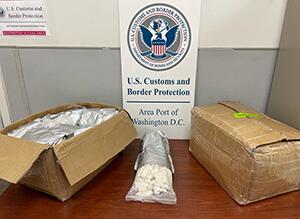
Last month, officers from the U.S. Customs and Border Protection (CBP) stationed at Washington Dulles International Airport intercepted two boxes destined for Washington, D.C. that turned out to possess about 71 pounds of a cathinone analogue.
Cathinone is a substance similar to amphetamines, registered as a Schedule I substance by the U.S. Drug Enforcement Administration (DEA). It can cause psychoactive and hallucinogenic effects, and is commonly sold in power and tablet form to mimic ecstasy or molly. In this case, the analogue was known as N,N-Dimethylpentylone Hydrochloride, a substance modified from the structure of cathinone.
“The synthetic stimulant market tries to stay one step ahead of law enforcement by continually tweaking cathinone’s chemical compounds to create new, yet still dangerous, analogues,” Christine Waugh, acting area port director for CBP’s Area Port of Washington, D.C., said. “Customs and Border Protection officers remain committed to protecting our communities by detecting these new illicit psychoactive stimulants and working with our federal, state, and local partners to hold importers accountable.”
The shipment seized at Washington Dulles was disguised as beauty products from China, contained within multiple vacuum-sealed bags. Following testing and positive identification, the drug was seized and turned over to special agents from Homeland Security Investigations (HSI) for further investigation.
According to the CBP, its officers and agents currently seize an average of 2,895 pounds of drugs per day at the various U.S. ports of entry. Synthetic stimulants like cathinone and its analogues have been linked to effects including high blood pressure, rapid heart rate, hyperthermia, dehydration, arrhythmias, hallucinations, loss of consciousness and death.




